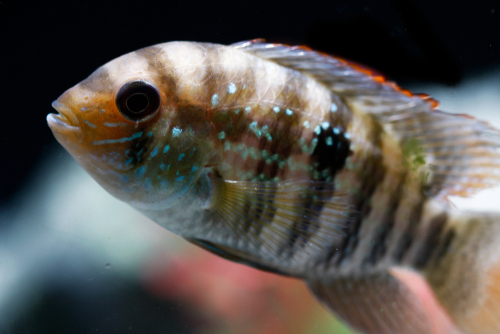Aequidens pulcher, more commonly known as Blue Acara, is a popular freshwater fish among fish owners. They are famous for their striking blue color, bringing beauty to any aquarium. If you own a Blue Acara, you might be searching for the perfect tank mates to join them.
The Blue Acara makes a great companion for a wide variety of freshwater aquarium fish due to their calmer nature. The Blue Acara is compatible with several fish, such as the angelfish, the pleco, the discus, the oscar, and the cory catfish.
The list of potential mates is lengthy, so let’s take a look at the 15 BEST tank mates for Blue Acara.
Contents
15 Best Blue Acara Tank Mates—What You Need to Know
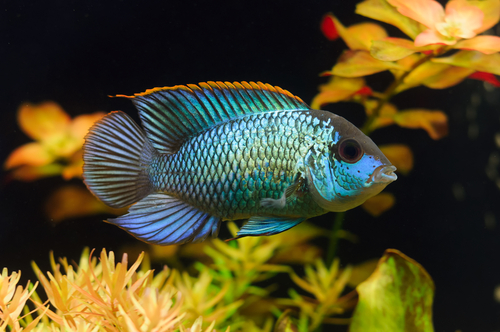
Before you can choose a tank mate for your Blue Acara, you should have a good understanding of these fish and what they need. This way you will know if the tank mate you’ve chosen will survive in the same environment as the Blue Acara.
The last thing you want to do is find a fish that works well with the Blue Acara socially but cannot survive in the aquarium you’ve introduced them to. It would be equally disappointing to find a fish that is compatible with your tank, but not with the Blue Acara themselves.
Before you select a tank mate, make sure you understand important characteristics and care parameters unique to your Blue Acara. This will help you rule out any obvious incompatibilities and cultivate a healthy community in your aquarium.
Temperament
Most Cichlids are considered aggressive, but the Blue Acara is only considered semi-aggressive. Although they are calmer cichlids, the Blue Acara is still prone to some aggressive tendencies when provoked.
Blue Acara are monogamous which means that pairing off to breed may stir up some aggression. They may begin to show territorial behaviors during spawning that is important to monitor them around other fish and the aquarium plants.
One important factor for the Blue Acara’s temperament is the type of fish you keep with them in the tank. Smaller fish will encourage the Blue Acara to bully them, so it is best to choose fish of a similar or larger size. Incredibly aggressive fish will bring out the Blue Acara’s aggression so it’s best to stay with fish who are semi-aggressive to peaceful behavior.
Size
The Blue Acara is a medium-sized, oval-shaped fish in the Cichlidae family. Cichlid sizes vary greatly based on the species, some only growing up to 2 inches while others grow up to 3 feet. The Blue Acara is a reasonably sized member of the Cichlidae family, growing anywhere from 4 to 8 inches in length.
Over the course of their 7-10 year lifespan, these fish will usually reach sexual maturity at about 2 ½ inches and may begin breeding when they reach about 4 inches. There is no standard size difference between males and females as there is with some fish.
Competition
The Blue Acara is great for beginners because it will not need an especially large tank, nor is it picky when it comes to food. The Blue Acara is carnivorous and will eat a wide variety of food such as bloodworms, brine shrimp, or protein tablets. This is another reason to avoid smaller tank mates, as they may be pursued as food.
Their feeding schedule should consist of anywhere from 2 to five pinches of fish food each day. It is better to feed Blue Acara multiple small servings throughout the day as opposed to one large meal. A once-weekly fasting day is also recommended for this fish. This keeps the fish healthy and the water quality cleaner.
Parameters ; Tank Setup
The Blue Acara naturally lives in the tropical freshwaters of South America and should be kept in an aquarium that mimics this environment. The Blue Acara must be kept in a 30-gallon tank or larger to have sufficient room to grow and explore. If you plan to expand your fish community, it is best to size up rather than start small.
A Blue Acara aquarium needs strong water movement, a water temperature of 72.0 to 85.0° F, and a pH level between 6.5 to 8. Additionally, they should have a moderate amount of lighting provided. Keeping aquarium plants with hearty roots is another recommendation for these tanks, as the Blue Acara are prone to burrowing in the substrate and uprooting plants.
The Blue Acara aquarium needs a sandy substrate that will allow the fish to burrow when stressed. One recommendation is to add a layer of dried leaves to encourage microbe growth. These microbes provide sustenance to the fry if your Blue Acaras happen to breed.
Blue Acara Tank Mates
One of the best parts of a tropical aquarium is the variety of colorful fish you can keep in them. Although the absolute best tank mate for a Blue Acara is another Blue Acara, there are still plenty of options if you want to add more color to your fish tank.
As we learned above, it’s important to take both the physical and social needs of the Blue Acara into account when introducing a new fish to your aquarium. Now that we’ve gotten to know the Blue Acara a little better, let’s find out which species are the best tank mates for these beautiful fish.
You will also like:
1. Rainbowfish
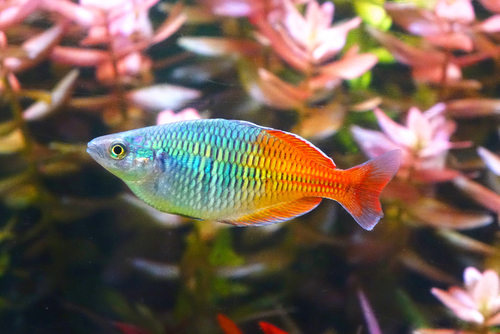
- Scientific Name: Melanotaeniidae
- Adult Size: 1” to 6”
- Compatible with: Dwarf Cichlids, large barbs, most nocturnal fish
- Water Temperature: 74 to 78° F
- Minimum tank size: 20 gallons
- Care Level: Beginner
- Origin: Australia and New Guinea
Melanotaeniidae, Blue Eyes, or the Rainbowfish, is a popular species in aquariums for its brilliant shiny colors. The Rainbowfish is omnivorous and will eat quality fish flakes or pellets supplemented with a variety of protein sources such as bloodworms or white worms.
The Rainbowfish has a relatively long lifespan of about 5 to 8 years, similar to the Blue Acara.
The Rainbowfish is an excellent tank mate for the Blue Acara because they have similar temperaments. The Rainbowfish is a bit shier but will work well with the calmer Cichlids. Additionally, they add another striking color to your aquarium when housed with Blue Acara.
2. Jack Dempsey

- Scientific Name: Rocio octofasciata
- Adult Size: 8” to 10”
- Compatible with: Other semi-aggressive Cichlids
- Water Temperature: 72.0 to 86.0° F
- Minimum tank size: 50 gallons
- Care Level: Beginner
- Origin: South America
Rocio octofasciata, or the Jack Dempsey, is another flashy fish that could make a great addition to your aquarium. Like the Blue Acara, they are another member of the Cichlidae family and can make great tank mates for each other. These beautiful fish have a long lifespan, living anywhere from 10 to 15 years!
They are prone to some aggression but are still considered less aggressive than most Cichlids. For this reason, it is best to keep them in a tank with the same species or with Cichlids of similar temperament. That being said, they can still make a great addition to your aquarium with the right care and behavior monitoring.
3. Oscar
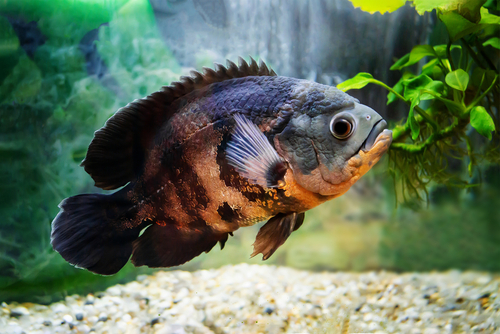
- Scientific Name: Astronotus ocellatus
- Adult Size: 14”
- Compatible with: Other Oscars, other moderate to large cichlids
- Water Temperature: 72.0 to 77.0° F
- Minimum tank size: 100 gallons
- Care Level: Beginner
- Origin: South America
Astronotus ocellatus, the Oscar, is one of the most classic aquarium fish around and make a great tank mate for the Blue Acara. Another member of the Cichlidae family, these fish have gorgeous red and black patterns that earned them the colloquial names, Tiger Oscar, Velvet Cichlid, and Marble Cichlid.
While the Oscar can make a great tank mate, it is important to note that these Cichlids are larger and are prone to eat smaller species if not carefully monitored.
That being said, with enough space an Oscar can be a great community member of your aquarium and can live over 10 years! Oscars are even capable of creating bonds with the humans they see outside the tank.
4. Pleco
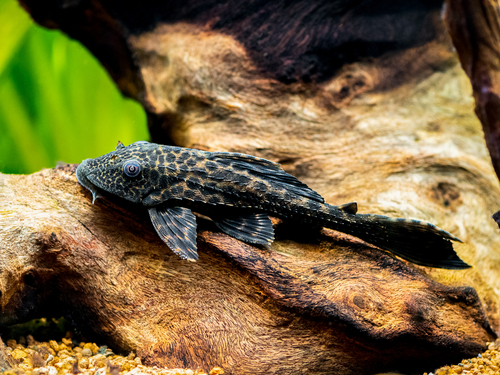
- Scientific Name: Hypostomus plecostomus
- Adult Size: Usually 12” to 15” but can get up to 24”
- Compatible with: Most tank mates including Cichlids
- Water Temperature: 66.0 to 79.0° F
- Minimum tank size: 55 gallons
- Care Level: Beginner
- Origin: Northern South America
Hypostomus plecostomus, the Pleco for short, is often commonly referred to as a ‘suckerfish’ because it feeds on the algae growing in the tank. The Pleco is one of the most common aquarium fish for this reason in addition to its hardiness. They can live from 10 to 15 years in captivity.
They are peaceful, nocturnal fish and will get along with most other tank mates. They are a popular choice because they help keep the tank clean by feeding on algae and other debris. It is important to note that they can eventually grow too large to fit in a tank with other fish and would eventually need a tank of their own if kept past their juvenile years.
5. Emerald Green Cory

- Scientific Name: Corydoras splendens
- Adult Size: 2 ¾” to 3 ½”
- Compatible with: Dwarf Cichlids, Tetras, Danios, and Rasboras
- Water Temperature: 68.0 to 82.0° F
- Minimum tank size: 30 gallon
- Care Level: Beginner
- Origin: South America
Corydoras splendens, or the Emerald Green Cory, is a member of the catfish family and another great tank mate for your Blue Acara. These small fish have an interesting green and pink coloration that compliments the bright blue of the Blue Acara. They are very hardy fish and can live up to 13 years under the right conditions.
The Emerald Green Cory is a peaceful fish that helps keep the waters clean by cleaning up leftover food from other fish. One important note about these fish is that they prefer to live in schools, so it is best to establish a small group of these fish in your aquarium as opposed to a single fish.
6. Lemon Tetra
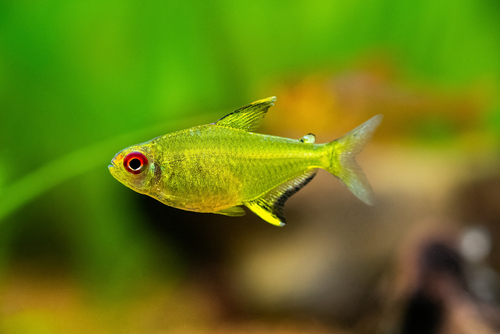
- Scientific Name: Hyphessobrycon pulchripinnis
- Adult Size: 2”
- Compatible with: Other peaceful fish
- Water Temperature: 72.0 to 82.0° F
- Minimum tank size: 15 gallon
- Care Level: Beginner
- Origin: South America
Hyphessobrycon pulchripinnis, or the Lemon Tetra, is another great option for Blue Acara tank mates. These fish thrive in schools, so it’s important to keep them in a group of 6 or more other Lemon Tetras. Although these fish are mostly translucent, they have striking lemon-yellow markings on their fins giving them their name.
The Lemon Tetra will live from 4 to 8 years in a tank and is a peaceful and friendly fish. They have a good temperament for the more peaceful Blue Acara but may be scared into hiding by more aggressive fish, so this is something to keep in mind when choosing other tank mates.
7. Congo Tetra
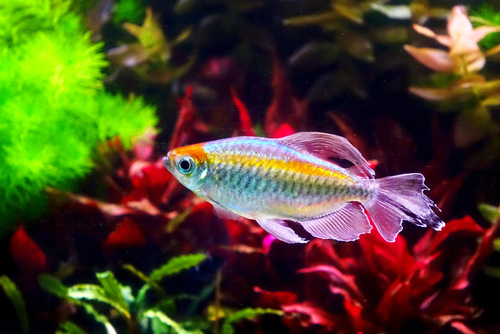
- Scientific Name: Phenacogrammus interruptus
- Adult Size: 3.4”
- Compatible with: Other Tetras, Dwarf Cichlids, Rainbowfish, Loricariids, Synodontis, and Corydoras
- Water Temperature: 73.0 to 82.0° F
- Minimum tank size: 40 gallon
- Care Level: Intermediate
- Origin: Africa
Phenacogrammus interruptus, or the Congo Tetra, is another wonderful tetra option for your Blue Acara tank. They have gorgeous luminescent rainbow scales on their body and feathery fins and tails. The Congo Tetra will generally live about 3 to five years in captivity.
These tetras are omnivorous and feed mainly on insects in the wild, but can be given pellets in your aquarium. They thrive in groups of six or more and will make peaceful, friendly additions to your aquarium. Their beautiful colors will shine even brighter in a group!
8. Harlequin Rasbora
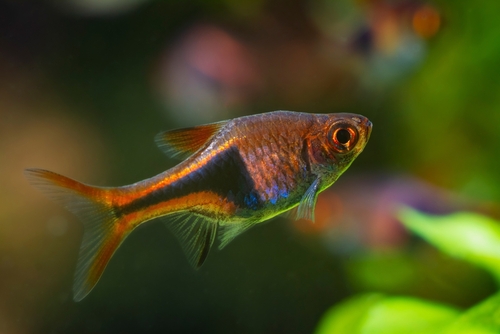
- Scientific Name: Trigonostigma heteromorpha
- Adult Size: 2”
- Compatible with: Dwarf Cichlids, Characins, Guppies, Plates, Mollies, Swordtail Fish, Loaches, and peaceful Catfish
- Water Temperature: 73.0 to 82.0° F
- Minimum tank size: 20 gallons
- Care Level: Intermediate
- Origin: Southeast Asia
Trigonostigma heteromorpha, or the Harlequin Rasbora, is a visually stunning fish ranging from orange to red to pink in coloration depending on where they were sourced. Their warm colors will make an excellent complement to the cool blue of the Blue Acara. The Harlequin Rasbora is very active and loves to show off their personalities.
These fish can live about 5 to 6 years in optimal conditions and are peaceful in nature. They are omnivorous, feeding mainly on insects, and like to live in groups of 10 or more. They may become nervous around larger fish, so it is not recommended to keep them with fish larger than a Blue Acara if you are considering larger tank mates.
9. Pearl Cichlid
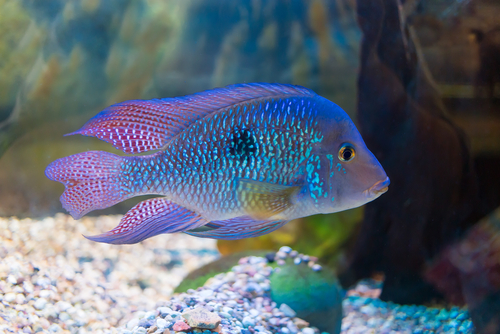
- Scientific Name: Geophagus brasiliensis
- Adult Size: 11”
- Compatible with: Discus, Blue Acara, and Angelfish
- Water Temperature: 68.0 to 73.0° F
- Minimum tank size: 40 gallons
- Care Level: Beginner
- Origin: South America
Geophagus brasiliensis, or the Pearl Cichlid, is a larger member of the Cichlidae family growing nearly a foot in length! This fish is grey-green and blue and changes color to brown, blue, or purple when spawning. They have a longer lifespan of about 15 years when kept in captivity.
The Pearl Cichlid is tolerant of other fish and works well with the Blue Acara and other semi-aggressive and peaceful fish. They are omnivorous and eat a similar diet to the Blue Acara, making feeding simple for you. However, it must be noted they become more aggressive when mating and should be monitored when this occurs.
10. Angelfish
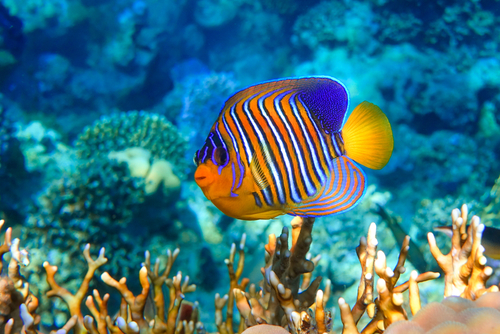
- Scientific Name: Pterophyllum scalare
- Adult Size: 6”
- Compatible with: Other Cichlids, peaceful and semi-aggressive fish
- Water Temperature: 75.0 to 82.0° F
- Minimum tank size: 30 gallons
- Care Level: Beginner
- Origin: South America
Pterophyllum scalare, or the Angelfish, are similar in size and temperament to the Blue Acara. Angelfish make a great addition to any aquarium because they come in so many different colors and patterns. They have long pointed fins that distinguish them from other members of the Cichlid family.
Much of The Angelfish and the Blue Acara share most personality traits which makes them such great tank mates. One difference in their behavior is that Angelfish are less prone to digging and uprooting plants which is great news when it comes to aquarium upkeep.
11. Convict Cichlid
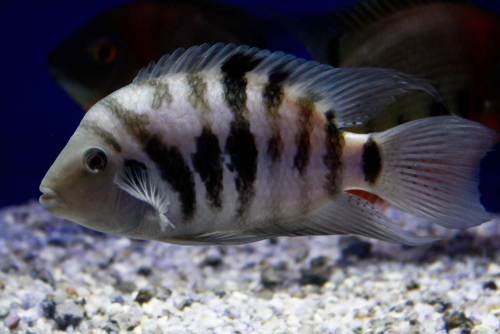
- Scientific Name: Archocentrus nigrofasciatus
- Adult Size: 6”
- Compatible with: Green Terror, Jack Dempsey, Blue Acara, and Rainbow Cichlid
- Water Temperature: 74.0 to 82.0° F
- Minimum tank size: 20 gallons
- Care Level: Beginner
- Origin: Central America
Archocentrus nigrofasciatus, or the Convict Cichlid, is white with black stripes and known for its zebra-like appearance. Similar to other Cichlids, the Convict Cichlid is an omnivore and not a picky eater, which makes them easy to fit into your feeding routine.
The Convict Cichlid may be smaller than the Blue Acara, but it is also more aggressive and therefore harder for your Blue Acara to bully. One important note about this fish is that because of its aggressive nature, it should not be housed with smaller fish which will affect the types of fish you can keep in the same tank.
12. Firemouth Cichlid
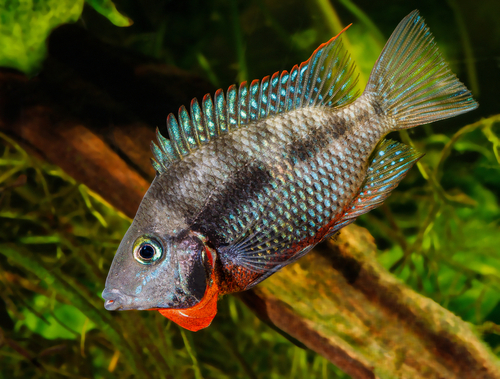
- Scientific Name: Thorichthys meeki
- Adult Size: 6.7”
- Compatible with: other Cichlids, fish of similar size and temperament
- Water Temperature: 70.0 to 75.0° F
- Minimum tank size: 30 gallons
- Care Level: Beginner
- Origin: Central America
Thorichthys meeki, or the Firemouth Cichlid, is distinct because of its bright red coloration on the belly and throat. Their bright red color contrasts beautifully with the Blue Acara’s vivid blue, making them a great tank mate choice.
The Firemouth Cichlid is omnivorous and will eat a similar diet to the Blue Acara, making feeding simple for you. They are semi-aggressive like the Blue Acara and of similar size so they make good community members together. They can become more aggressive during spawning like many other fish and should be closely monitored during this time.
13. Discus
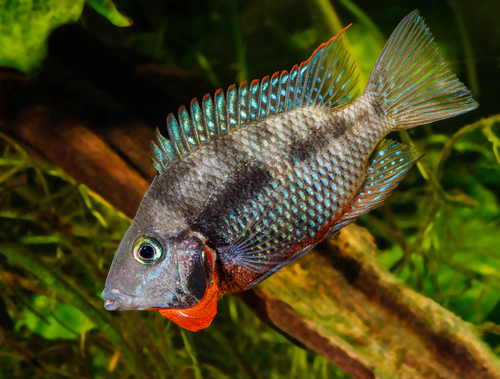
- Scientific Name: Symphysodon aequifasciata
- Adult Size: 10”
- Compatible with: Loaches, Dwarf Cichlids, and tetra
- Water Temperature: 82.0 to 88.0° F
- Minimum tank size: 50 gallons
- Care Level: Advanced
- Origin: South America
Symphysodon aequifasciata, or the Discus, is a strikingly colored fish with a disk-like shape. They come in red, green, and blue variations and are highly esteemed in the aquarist community for their beauty. The Discus is carnivorous and enjoys a variety of live and fresh foods such as bloodworms and brine shrimp.
They are more peaceful than the Blue Acara and a bit larger, so they make excellent tank mates. Discus are highly social and need to be kept in schools. They are high-maintenance fish, but they are well worth the work because they make such great tank mates for the Blue Acara.
14. Silver Dollar

- Scientific Name: Metynnis argenteus
- Adult Size: 5.9”
- Compatible with: Other Silver Dollar species, more peaceful South and Central American Cichlids, Anostomus, Arawana, Pacus, and larger peaceful catfish
- Water Temperature: 75.0 to 82.0° F
- Minimum tank size: 75 gallon
- Care Level: Intermediate
- Origin: South America
Metynnis argenteus, or the Silver Dollar, is another striking fish that works well as a tank mate for the Blue Acara. These fish can live up to 10 years or more in proper conditions. They are technically omnivorous, but they consume a mostly vegetarian diet.
One thing to note about these fish is that they must be kept in groups of 5 or more to properly thrive. They do well in community tanks with larger fish, especially more peaceful varieties. They are prone to eat smaller fish which is something to consider when bringing these fish home.
15. Nicaragua Cichlid
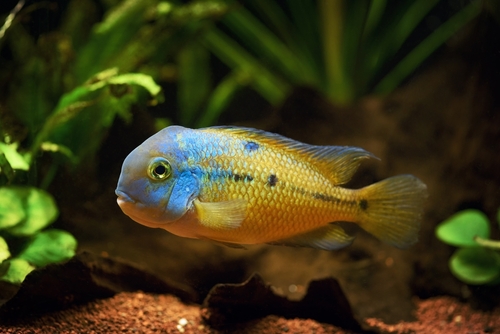
- Scientific Name: Hypsophrys nicaraguensis
- Adult Size: 9.8”
- Compatible with: Cichlids of similar temperament and size
- Water Temperature: 74.0 to 80.0° F
- Minimum tank size: 50 gallons
- Care Level: Intermediate
- Origin: Central America
Hypsophrys nicaraguensis, or the Nicaragua Cichlid, is a gorgeous fish sporting gold, emerald, and blue colors when fully grown. They have a lifespan of up to 15 years when kept in proper conditions. They are omnivorous and will eat anything from seeds to live food.
The Nicaragua Cichlid makes a great tank mate for the Blue Acara because of their similarity in size and temperament. They are just a bit larger, but they tend to socialize well together. They have similar behavior patterns, becoming more aggressive and uprooting plants during spawning.
Outro
Choosing a new tank mate for your Blue Acara can be overwhelming when you don’t know where to start. The Blue Acara is a great fish for beginners because there are so many popular tropical freshwater fish that make suitable tank mates for them.
After reviewing the 15 best Blue Acara tank mates, we see that Cichlids, Catfish, and Rasbora are all good choices because they have similar physical and social needs.
It is important to choose fish of similar size and compatible temperaments to avoid unnecessary stress in your aquarium. Now you can feel confident knowing that you have so many great options to choose from when selecting a Blue Acara tank mate.
Frequently Asked Questions
What other Cichlids can live with Blue Acara?
The Angelfish, Discus, Uaru Cichlid, and Pearl Cichlid are excellent tank mates for the Blue Acara. Because the Blue Acara is originally from South America, many South American Cichlids are compatible.
Is there a difference between Blue Acara and Electric Blue Acara?
The Electric Blue Acara is typically smaller and more brightly colored than the normal Blue Acara. They are more likely to have deformities than the normal Blue Acara and are of a more peaceful temperament.
How many Blue Acara are in a 30 gallon?
A 30-gallon tank is suitable for 1 to 2 Blue Acara, however, if you are planning to have more than 2 you will need to increase your tank size by 15 gallons.

Ian Sterling, founder of Fishlab.com, began his aquarium journey over 30 years ago, driven by a deep fascination for fish and their diverse personalities. His website, Fishlab.com, is dedicated to making fishkeeping accessible and enjoyable, offering beginner-friendly guidance, expert insights, and a community for aquarists to connect and share experiences.


